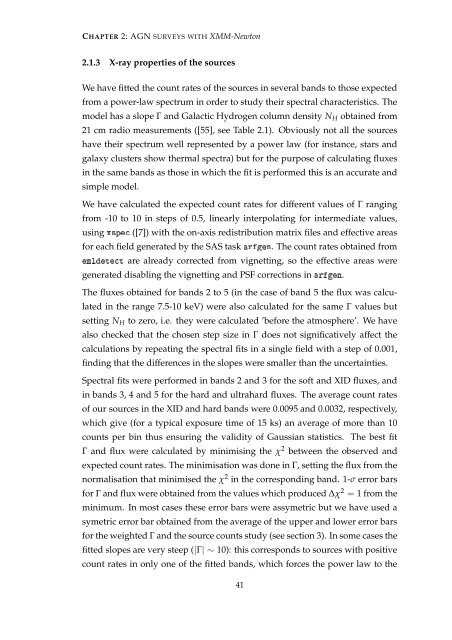pdf - SRON
pdf - SRON
pdf - SRON
You also want an ePaper? Increase the reach of your titles
YUMPU automatically turns print PDFs into web optimized ePapers that Google loves.
CHAPTER 2: AGN SURVEYS WITH XMM-Newton<br />
2.1.3 X-ray properties of the sources<br />
We have fitted the count rates of the sources in several bands to those expected<br />
from a power-law spectrum in order to study their spectral characteristics. The<br />
model has a slope Γ and Galactic Hydrogen column density N H obtained from<br />
21 cm radio measurements ([55], see Table 2.1). Obviously not all the sources<br />
have their spectrum well represented by a power law (for instance, stars and<br />
galaxy clusters show thermal spectra) but for the purpose of calculating fluxes<br />
in the same bands as those in which the fit is performed this is an accurate and<br />
simple model.<br />
We have calculated the expected count rates for different values of Γ ranging<br />
from -10 to 10 in steps of 0.5, linearly interpolating for intermediate values,<br />
using LSIF1;1A<br />
([7]) with the on-axis redistribution matrix files and effective areas<br />
for each field generated by the SAS TJUV§;7W task . The count rates obtained from<br />
are already corrected from vignetting, so the effective areas were<br />
generated disabling the vignetting and PSF corrections in TJ0UV§;7W .<br />
;D=2?§;2@B;BAD@<br />
The fluxes obtained for bands 2 to 5 (in the case of band 5 the flux was calculated<br />
in the range 7.5-10 keV) were also calculated for the same Γ values but<br />
setting N H to zero, i.e. they were calculated ’before the atmosphere’. We have<br />
also checked that the chosen step size in Γ does not significatively affect the<br />
calculations by repeating the spectral fits in a single field with a step of 0.001,<br />
finding that the differences in the slopes were smaller than the uncertainties.<br />
Spectral fits were performed in bands 2 and 3 for the soft and XID fluxes, and<br />
in bands 3, 4 and 5 for the hard and ultrahard fluxes. The average count rates<br />
of our sources in the XID and hard bands were 0.0095 and 0.0032, respectively,<br />
which give (for a typical exposure time of 15 ks) an average of more than 10<br />
counts per bin thus ensuring the validity of Gaussian statistics. The best fit<br />
Γ and flux were calculated by minimising the χ 2 between the observed and<br />
expected count rates. The minimisation was done in Γ, setting the flux from the<br />
normalisation that minimised the χ 2 in the corresponding band. 1-σ error bars<br />
for Γ and flux were obtained from the values which produced ∆χ 2 = 1 from the<br />
minimum. In most cases these error bars were assymetric but we have used a<br />
symetric error bar obtained from the average of the upper and lower error bars<br />
for the weighted Γ and the source counts study (see section 3). In some cases the<br />
fitted slopes are very steep (|Γ| ∼ 10): this corresponds to sources with positive<br />
count rates in only one of the fitted bands, which forces the power law to the<br />
41
















